Humanizing AI text refers to making the content generated by AI systems more relatable and natural, resembling human communication. This involves incorporating empathy, humor, and personalization into the text to enhance the user experience and create a sense of connection. By humanizing AI text, we aim to bridge the gap between machine-generated content and human interaction, making it more engaging and enjoyable for users.
Research suggests that people would be more likely to trust news articles written by a human journalist than by an AI system. This means users are more likely to engage with and trust content that feels like a human rather than a machine wrote it.
As an AI prompt engineer, I have developed techniques to infuse AI-generated text with personality and emotion, ensuring it resonates with users on a deeper level. By incorporating elements of human communication, such as storytelling and conversational language, we can create AI text that provides information and evokes an emotional response from the reader.
So how can we do it effectively? Read on to discover some strategies and online tools for humanizing AI text.
What Does It Mean to “Humanize AI Text”?
To “humanize AI text” means to infuse it with qualities that mimic human communication, such as empathy, humor, and personalization. It is about creating content that resonates with users on a deeper level, making them feel understood and connected. This approach acknowledges the limitations of AI systems in fully replicating human interaction but strives to enhance the user experience by making the text more relatable and natural.
It can also mean making AI content undetectable from human-generated content, blurring the lines between what is written by a human and what is generated by AI. This can be achieved through advanced natural language processing techniques and sophisticated algorithms that mimic human writing styles and patterns.
Organizations can create more engaging and personalized user experiences by humanizing AI text, building stronger connections, and fostering trust in AI-powered systems.
Human-Written vs. AI-Generated Content: Why Humanization Matters
Human-written content often reflects the author’s unique perspectives, emotions, and creativity, making it relatable and authentic. On the other hand, AI-generated content can be produced at a much faster rate and can be tailored to specific requirements, allowing for scalability and efficiency. But why exactly does humanization matter? Here are five of the benefits of humanizing AI text:
1. Building Trust
When AI-generated content is humanized, it creates a sense of trust and credibility among users. People are more likely to engage with authentic and relatable content as it reflects a genuine understanding of their needs and preferences. By incorporating human elements into AI-generated text, companies can establish stronger connections with their audience, fostering trust in AI-powered systems.
2. Emotional Connection
Human-written content can evoke emotions in readers. Humanized AI text can tap into these emotional responses through storytelling, humor, or empathy, creating a deeper connection with users. This emotional engagement enhances the user experience and increases the likelihood of users remembering and sharing the content, ultimately benefiting the brand or organization.
3. Personalization
Humanization allows for the customization of AI-generated content based on individual preferences. Companies can tailor their messaging to resonate with specific target audiences by understanding users’ unique characteristics and interests. This level of personalization not only increases user satisfaction but also improves conversion rates and overall engagement.
4. Adaptability
Human-written content is adaptable and flexible, allowing quick adjustments based on real-time feedback or changing market trends. AI-generated content, when humanized, can also be easily modified and refined to meet evolving needs. This adaptability ensures the content remains relevant and up-to-date, maintaining user interest and driving continued engagement.
5. Creativity and Innovation
Humanization brings a creative and innovative touch to AI-generated text. While AI algorithms can generate content based on patterns and data, human input adds an element of originality and out-of-the-box thinking. By infusing creativity into AI-generated text, companies can stand out from competitors, captivate their audience, and inspire new ideas and solutions.
5 AI Text Humanization Practices for Better Engagement
1. Use conversational language
One way to humanize AI-generated text is to use conversational language that mimics how people naturally speak and interact with each other. This can make the content feel more relatable and engaging to readers as if they are conversing with a real person. By avoiding overly formal or robotic language, companies can create a more friendly and approachable tone that resonates with their audience.
2. Incorporate storytelling elements
Humans are naturally drawn to stories, so incorporating storytelling elements into AI-generated text can make it more compelling and relatable. By weaving narratives, anecdotes, or personal experiences into the content, companies can create a connection with their readers and evoke emotions. This not only enhances engagement but also helps to convey information in a more memorable and impactful way.
3. Show empathy and understanding
Another way to humanize AI text is to show empathy and understanding for the reader’s needs and concerns. This can be done by acknowledging common pain points, providing helpful solutions, or offering support and reassurance. Companies can build trust and establish a meaningful connection with their audience by demonstrating that the content is tailored to address the reader’s specific challenges or interests.
4. Encourage user interaction and feedback
Humanization can also be achieved by actively involving users in the content creation. By encouraging user interaction, such as asking for opinions, inviting feedback, or initiating discussions, companies can make the readers feel like active participants rather than passive consumers. This boosts engagement and allows companies to gather valuable insights and refine their AI-generated text based on user preferences and feedback.
5. Be transparent about AI involvement.
Lastly, transparency is crucial when humanizing AI-generated text. By openly acknowledging the use of AI technology and its limitations, companies can build trust and credibility with their audience. This can be done through disclaimers, explanations of how AI algorithms work, or even showcasing the collaborative efforts between humans and AI in content creation. By being transparent, companies can ensure readers know the human touch that goes into the AI-generated text and foster a more authentic and genuine connection.
How to Humanize AI Text Using Online Tools
- Start by selecting a reliable online tool that specializes in humanizing AI-generated text.
- Input the AI-generated text into the online tool.
- Use the tool’s features to make necessary adjustments and improvements to the text, focusing on tone, clarity, and readability.
- Review and edit the text manually to ensure it aligns with your desired human touch and style.
- Consider incorporating personal experiences, anecdotes, or examples that resonate with your audience to enhance the text’s humanization further.
- Proofread and double-check for any errors or inconsistencies in grammar, punctuation, or formatting.
- Repeat the process as needed until you are satisfied with the final version of the AI-generated text that has been humanized using online tools.
Top 5 Humanize AI Text Tools for Undetectable AI Content
Several tools can help you achieve a more natural and engaging tone when humanizing AI-generated text. Here are the top five tools that can assist you in creating undetectable AI content:
1. Grammarly
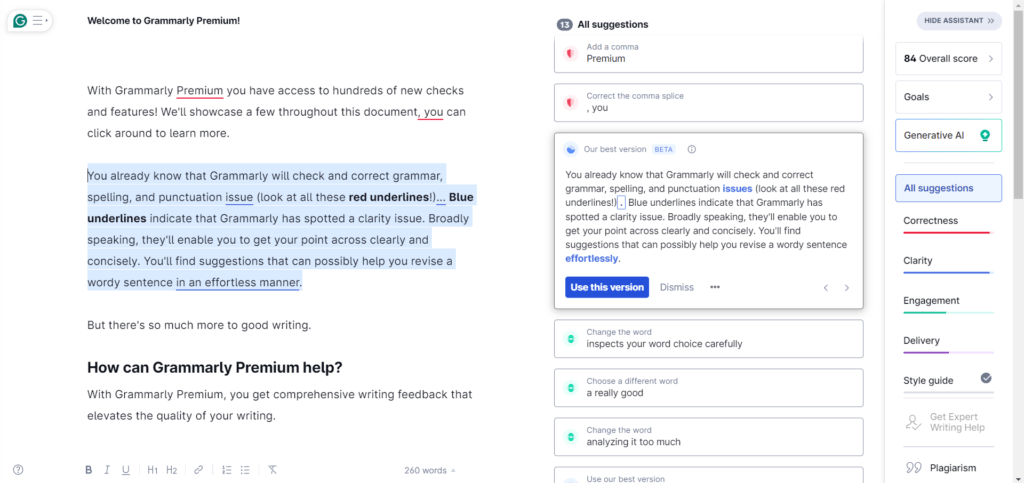
This popular online tool not only corrects grammar and spelling errors but also provides suggestions for improving clarity and readability. It can help you identify areas where the text may sound too robotic and offer alternative phrasing to make it sound more human.
2. Hemingway Editor
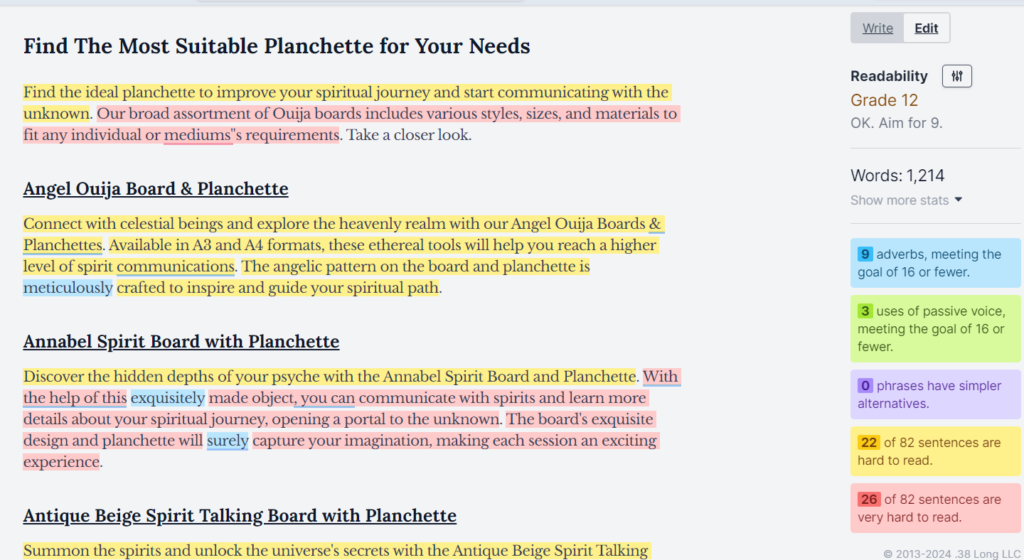
Known for its simplicity and user-friendly interface, Hemingway Editor highlights complex sentences, excessive adverbs, and passive voice, helping you transform the text into a more concise and direct style. Following its suggestions can make your AI-generated content sound more conversational and relatable.
3. Readable
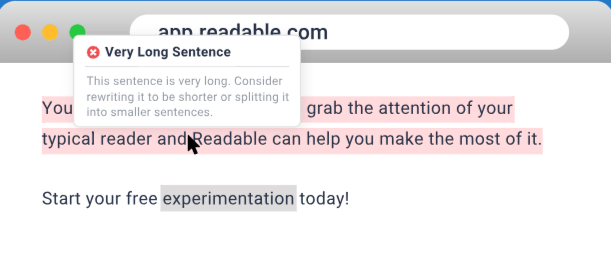
This tool analyzes your text’s readability by considering sentence length, word complexity, and paragraph structure. It provides a readability score and offers suggestions to improve the overall flow and comprehension of the content. Using Readable can ensure that your AI-generated text is accessible and engaging to many readers.
4. ProWritingAid
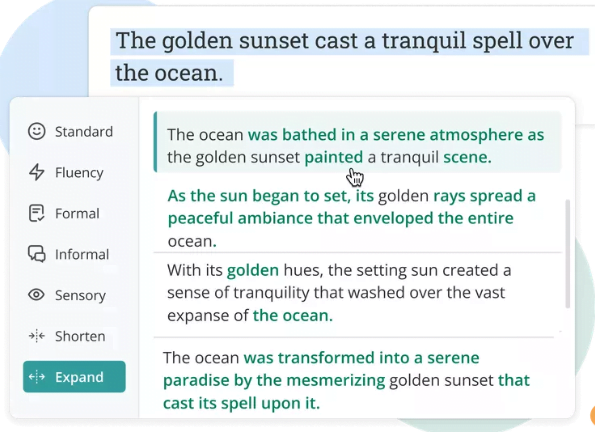
This comprehensive writing assistant offers a range of features to enhance the human touch in your AI-generated content. It checks for grammar and spelling errors, suggests sentence structure and style improvements, and even provides insights on overused words or phrases. ProWritingAid can help refine your text to sound more authentic and resonate with your audience.
5. Wordtune

With its AI-powered suggestions, Wordtune can help you rephrase sentences and find alternative words to make your AI-generated text more expressive and natural. It provides multiple options for rewriting specific phrases, allowing you to choose the one that best aligns with your desired human touch and style.
Utilizing these top five humanize AI text tools allows you to take your AI-generated content to the next level, making it virtually indistinguishable from human-written text. Remember to review and edit the text manually, incorporating personal experiences or examples that resonate with your audience to enhance its humanization further.
The 3 Best AI Humanizers
1. AISEO Bypass Tool
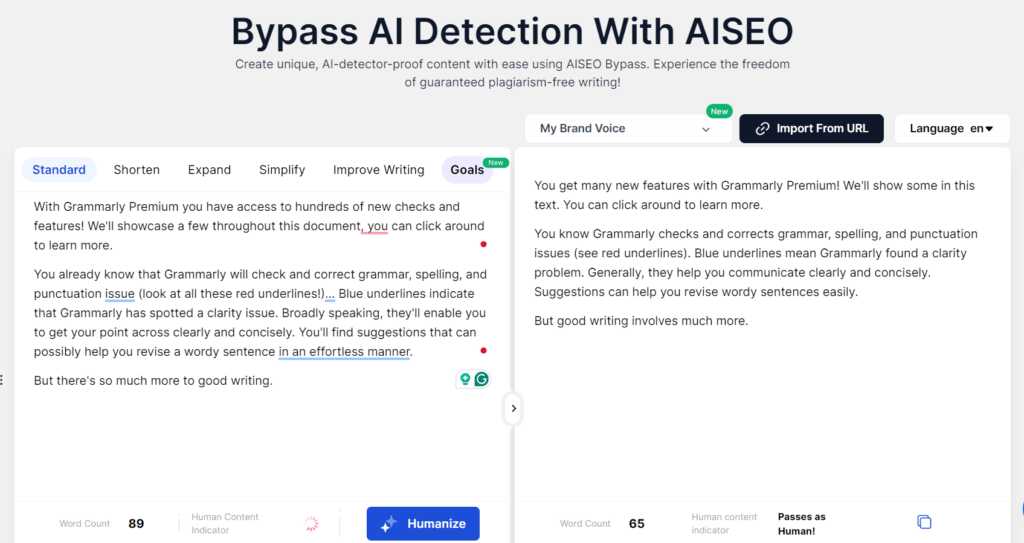
AISEO offers a range of features that allow you to add a human touch to your AI-generated text. With its advanced algorithms, it can effectively mimic human writing styles and create engaging and relatable content. By using the AISEO Bypass Tool, you can easily enhance the naturalness and expressiveness of your AI-generated text, making it more appealing to your audience.
2. AI Text Converter

The AI Text Converter has a user-friendly interface that allows you to input your text and customize it to sound more natural and personal. With its extensive database of language patterns and expressions, the AI Text Converter can help you create content that resonates with your audience on a deeper level. By incorporating personal experiences or examples, you can further enhance the humanization of your text and make it relatable to your readers.
3. UndetectableAI

UndetectableAI ensures that the generated text is indistinguishable from human-written content. Its advanced algorithms and sophisticated language models guarantee that the output is seamless and free from robotic or artificial characteristics. This not only boosts the credibility of your text but also creates a more immersive and engaging experience for your audience.
FAQs About Humanizing AI Text
What Industries Can Benefit from AI-made Content?
AI-made content can benefit various industries, including marketing, advertising, journalism, e-commerce, and customer service. By using AI to generate content, businesses can save time and resources while maintaining high quality and relevance in their messaging.
Does AI-Generated Content Pass as Authentic?
AI-generated content can often pass as authentic, especially when carefully crafted to mimic human language and tone. However, the level of authenticity that AI can achieve is still limited, as it may lack the emotional intelligence and creativity that come naturally to humans.
Businesses must balance using AI for efficiency and personalizing content to ensure it resonates with their target audience. By incorporating human elements into AI-generated content, such as personal anecdotes or unique insights, businesses can create a more genuine and relatable message that connects with their customers on a deeper level.
Can AI truly replicate human writing style?
While AI has significantly improved in mimicking human writing style, it may struggle to capture specific nuances and subtleties. For instance, it may still struggle to convey emotions, humor, or sarcasm in a way that truly resonates with readers.
Additionally, the element of spontaneity and improvisation that comes with human creativity is difficult to replicate in AI-generated content. As such, businesses should be mindful of these limitations and continue to prioritize human input and oversight in their content creation processes.
Can AI Replace Human Content Creators?
While AI technology has undoubtedly made great strides in recent years, it is unlikely to replace human content creators fully. The unique perspectives, experiences, and emotions humans bring to their writing cannot be replicated by algorithms alone.
Furthermore, the human touch often sets content apart and makes it engaging and relatable to audiences. AI should be viewed as a supplement to, rather than a replacement for, human creativity and insight.
What are the concerns related to AI-generated content?
One primary concern related to AI-generated content is the potential for bias and lack of diversity in the information produced. Since AI algorithms are trained on existing data, they may perpetuate and amplify societal biases.
What role does human editing play in AI-generated content?
Human editing ensures that AI-generated content is accurate, ethical, and inclusive. Editors can review and revise AI-generated content to remove biased or inappropriate language, fact-check information, and ensure that the overall message aligns with the organization’s values and goals.
Additionally, human editors can inject creativity and originality into the content, making it more engaging and impactful for audiences. By combining AI’s efficiency with the expertise and judgment of human editors, organizations can create high-quality content that resonates with their target audience and upholds ethical standards.


